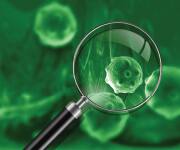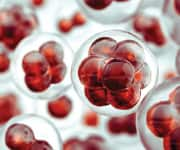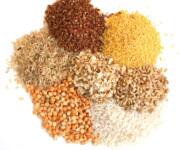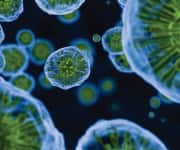Life Extension Magazine®
Scientists have recently been focused on a new class of drugs1 aimed at eliminating aging cells from our bodies.
The goal of these experimental drugs is to eliminate poorly functioning, senile cells that clog our bodies and induce a range of degenerative illnesses.
This form of biological housekeeping frees the body from sluggish, slowly dying cells and allows it to function better with newer, healthier cells. This rejuvenation occurs naturally in our youth but declines with age.
Researchers have discovered that two natural compounds target and discard aging cells from the body, making way for the production of new, healthy cells.
What you need to know
- The accumulation of non-replicating aging cells in healthy tissue promotes aging throughout the body.
- At the same time, cancer cells lose the ability to grow old and stop replicating, leaving them free to multiply endlessly, invading and destroying tissue as they go.
- Tocotrienols, members of the vitamin E family, have recently been shown to exert dualistic actions on healthy and malignant cells, stimulating natural growth and delaying senescence in otherwise healthy cells, but inducing senescence and stopping growth in malignant cells.
- These properties make tocotrienols among the most promising senolytic compounds that are readily available.
- Tocotrienols have also been shown to fight type II diabetes, and metabolic syndrome, while also delaying neurodegeneration.
Targeting Cellular Senescence

Cellular senescence is an underlying contributor to accelerated aging and disease.2
Aging, or “senile,” cells stop dividing to produce new cells and lose their ability to die off, which causes them to build up in the body. These accumulated cells pour out harmful, pro-inflammatory chemicals and other signaling molecules that contribute to aging and increase the risk of most age-related diseases—including cancer.3-5
Ridding the body of these aging cells to make way for fresh new cells is an important target for slowing aging and reducing disease risk.6 This is the goal of pharmaceutical researchers as they develop new drugs to purge senile cells from aging bodies.
But senescence is a double-edged sword. While it is harmful in healthy cells, senescence is desirable in tumor cells because it halts their out-of-control replication. By definition, cancer cells have become “immortal,” and continue to replicate without forming useful structures. By “turning back on” the senescence process, cancer cells can be made “mortal” again and eventually die off. In fact, deliberately triggering senescence in malignant cells represents a new approach to fighting cancer.6
The idea that we can use natural substances to selectively target cellular senescence has opened a promising new door in the fight against cancer and aging.6
Studies have used drugs and synthetic biological products capable of clearing away accumulated aging cells in aging tissues. In animals, these compounds have produced dramatic results, such as delaying the onset of aging, slowing existing age-related changes, and even extending lifespans.7-9 But in their current state of development, these drugs and other synthetic products are impractical, dangerous, or both, making them entirely unsuitable for use in humans to prevent either aging or cancer.
Researchers have found that two natural compounds, when combined, successfully remove aging cells from the body without harmful side effects.
Tocotrienols + Quercetin
Tocotrienols, the less well-known members of the vitamin E family, are emerging as the ideal senolytic nutrient. Studies show that tocotrienols have dual and complementary actions:
- In cancer cells, tocotrienols can stimulate cellular senescence, shutting down their malignant potential.6
- In healthy tissue, tocotrienols can slow aging changes, promote normal cell division and specialization, and prevent cells from reaching their damaging final aging state.10-14
Studies have shown the benefits of combining tocotrienols with quercetin, a flavonol found in many fruits and vegetables. Quercetin also has dual and complementary actions with regards to aging cells. Like tocotrienols, quercetin can induce senescence and promote cell death in numerous types of cancer cells.6,15 And, like tocotrienols, quercetin has the opposite effect in healthy cells, delaying senescence in younger cells and rejuvenating older cells to rid them of their abnormal, age-promoting function.1,6
Together, these two nutrients sweep the body clear of aging cells, while promoting natural termination of cancer cells.
Combined Anti-Aging Effects
Several studies have now been performed on the combination of tocotrienols and quercetin in slowing, delaying, or even reversing the consequences of senescence—particularly the excessive inflammatory signals that aging cells produce.16-18
A key reason why aging cells are so closely tied to aging and disease is because they pour out substances that generate inflammation throughout the body.3,19 In fact, aging cells are now recognized as an important source of the chronic inflammation that is known to produce age-related diseases.16
Growing evidence from animal models shows that the combination of tocotrienols plus quercetin sharply reduces blood levels of pro-inflammatory molecules.16 By suppressing these damaging factors, tocotrienols and quercetin reduce systemic inflammation in the body.17,18 Reducing inflammation has the beneficial effect of reducing the overall risk of aging and disease.
What Are Aging Cells?
 |
Cellular senescence is a natural process by which cells lose their ability to continue to divide. This process is essential for the prevention of cancer because it puts an upper limit on normal cell replications. It is also essential in tissue remodeling which occurs during development of embryos and during wound healing.9 In both of these special cases, rapid cell replication must be balanced by appropriate growth arrest so that normal structures form.
But aging cells remain alive, surviving in tissues without contributing much to the overall health of the organism over time.9 Worse, aging cells disrupt tissue structures and alter tissue function because of certain molecules that they secrete.7 Chief among these deleterious signaling molecules are mediators of inflammation (cytokines and other pro-inflammatory molecules).3,19
These inflammatory changes spread to other cells in the area, hastening their own decline into an aging state, and further accelerating the overall aging of the organism.3,19
Conversely, when cells lose their ability to age, they continue to grow far past their natural limits.54
Thus, gaining precise control over the process of cellular senescence would represent a huge breakthrough in our ability to slow aging (by preventing aging changes and/or clearing away aging cells), and in our capacity to fight cancer (by deliberately inducing aging changes in malignant cells to stop their growth).
New Approach to Fighting Cancer
As we’ve seen, cancer cells are essentially “immortal” in part because they have lost the ability to enter senescence, and hence, to stop their out-of-control replication. That means that deliberately inducing senescence in cancer cells is a potentially effective method of slowing or stopping a tumor from continuing to grow—or even from developing in the first place.
Mounting evidence has demonstrated that treating malignant cells with tocotrienols has several anti-tumor effects, including:
- Inducing mitochondrial damage, which starves cancer cells of energy, and
- Inducing apoptosis, the normal cell death program that cancer cells lose.20-24
What is so remarkable is that these cell-damaging effects are not seen in healthy, non-malignant cells, which means that tocotrienols selectively target cancer cells.21
In addition to helping prevent the growth and development of tumors, it appears that tocotrienols could also play a role in preventing them from spreading to other parts of the body. Studies of cultured cells show that tocotrienols are intimately involved in the regulation of tumor cell invasion and metastases, through their intricate control of sign-aling pathways used by those cells.25
One specific member of the tocotrienol family, gamma tocotrienol, has its own list of actions against cancer cells. These include blocking the formation of new blood vessels (angiogenesis) that is required to feed fast-growing tumors, thereby starving them of their nutrient and oxygen sources,26,27 and inhibiting the production of the inflammatory molecules that are associated with aging cells and that promote cancer growth.28
Tocotrienols: Nature’s Original Anti-Aging Compounds
 |
Tocotrienols are members of the vitamin E family of essential nutrients, naturally found in barley, wheat germ, and certain types of grains and nuts.55 There are four tocotrienols, just as there are four tocopherols, which are the more familiar form of vitamin E, and are similarly labeled alpha, beta, gamma, and delta.55-57 Early research, however, focused almost exclusively on the tocopherol class, and not the tocotrienol class. In a review of all publications on vitamin E, only about 3% have examined the utility of tocotrienols.56
But tocotrienols are now recognized to be an important part of the spectrum of the eight different forms of vitamin E, particularly for their anti-inflammatory, cholesterol-lowering, and radiation-protecting properties.56,57
Now, tocotrienols are being shown to have a still more fundamental role in human health and aging, through their abilities to modulate cellular senescence. This finding may in fact represent tocotrienols’ most fundamental natural purpose. One recent study by botanists shows that tocotrienols in the outer layer of seeds reduce metabolic activity in the seed during stressful external conditions.58 Those conditions resemble the accumulated stress seen in aging, and, if not prevented in the developing plant embryo, lead to death of the seed.
Thus, tocotrienols appear to be one of nature’s anti-aging compounds. We are now learning just how applicable their properties are in human aging as well.
Impressive Studies

Laboratory and preclinical studies suggest that tocotrienols may combat senescence-related deterioration. One in vitro experiment showed that tocotrienols may reverse premature aging of muscle cells by enhancing their regenerative capacity.29 Another cell study found that tocotrienols reversed senescence-associated cell cycle arrest, reduced DNA damage, and restored telomerase activity in human connective tissue cells.30 Several other lab studies have revealed similarly intriguing findings.6,31 In aged mice, tocotrienols increased mitochondrial function in the brain,32 and reduced the age-related decline in T-cell function.33
The ability of tocotrienols to slow the growth of cancer cells—as well as enhance their ability to die off naturally—has led to impressive results in animal studies of cancer.
One study showed that in mice that had been injected with human colon cancer cells, those being fed tocotrienol-rich plant oil demonstrated a significant inhibition of tumor growth.34
But what makes tocotrienols particularly unique is that while they induce senescence in cancer cells, they prevent aging changes in healthy tissues. This ability to selectively target cancer cells while protecting healthy cells was clearly seen in a study utilizing high doses of radiation.
Radiation therapy is often used in the treatment of malignant tissues, with the aim of destroying cancer cells. Unfortunately, this has the obvious side effect of producing radiation damage in healthy tissue as well, which can lead to premature cell senescence, dysfunction, and death—particularly in tissues with normally rapid cell turnover, such as the intestine. It can also lead to potentially life-threatening side effects and considerable misery.
But something remarkable happened when mice were supplemented with tocotrienols (human equivalent dose of
1 gram) prior to whole-body
radiation. Normal intestinal cells sharply increased their expression of life-preserving genes that prevent
cell death by apoptosis. In other words, while
tocotrienols are senescence-inducing in cancer cells, this experiment showed that
tocotrienol supplementation prevented radiation-induced aging changes in healthy
tissue.35
Several trials have shown benefits with daily doses of roughly 40–400 mg of tocotrienols in relation to lipid metabolism,36-44 brain health,42 liver health,43,44 immune system function,45 and prevention of damage to DNA.46
Practical Suggestions
 |
Quercetin is a low-cost dietary supplement that has health-promoting properties in the heart, brain, and other systems.
Doses of 250-500 mg per day of quercetin (5-10 mg of quercetin phytosome) have demonstrated benefits and might be a good maintenance dose.
For tocotrienols, use a palm-oil derived source and take around 150 mg per day for the first three months with a maintenance dose after that of about 100 mg each day thereafter.
As of the time of this article, the anti-senescence properties of these ingredients have only been demonstrated in cell studies and/or animal models. Research in humans is needed to establish an ideal dosage regimen for these ingredients to combat cellular senescence in humans.
Note: If you are taking anti-coagulant or anti-platelet medications, or have a bleeding disorder, consult your healthcare provider before taking tocotrienols.
Summary
Tocotrienols, the less well-known members of the vitamin E family, are of great interest to researchers. Recent studies show that tocotrienols have the ability to slow cellular aging in normal tissues, while reducing inflammation. At the same time, in what seems to be a remarkable fashion, tocotrienols may accelerate the destruction of cancer cells.
Tocotrienols, particularly in combination with quercetin, appear capable of removing many aging cells.
Tocotrienols have other anti-aging effects that are proving beneficial in our fight against diabetes, metabolic syndrome, and neuro-degeneration.42,47-53
If you have any questions on the scientific content of this article, please call a Life Extension® Wellness Specialist at 1-866-864-3027.
Editor's Note:
Science continues to evolve, and new research is published daily. As such, we have a more recent article on this topic here: Major Advance in Healthy Longevity: Senolytics
References
- Zhu Y, Tchkonia T, Pirtskhalava T, et al. The Achilles’ heel of senescent cells: from transcriptome to senolytic drugs. Aging Cell. 2015;14(4):644-58.
- Bhatia-Dey N, Kanherkar RR, Stair SE, et al. Cellular Senescence as the Causal Nexus of Aging. Frontiers in Genetics. 2016;7:13.
- Lasry A, Ben-Neriah Y. Senescence-associated inflammatory responses: aging and cancer perspectives. Trends Immunol. 2015;36(4):217-28.
- Chinta SJ, Woods G, Rane A, et al. Cellular senescence and the aging brain. Exp Gerontol. 2015;68:3-7.
- Sikora E, Bielak-Zmijewska A, Mosieniak G. Cellular senescence in ageing, age-related disease and longevity. Curr Vasc Pharmacol. 2014;12(5):698-706.
- Malavolta M, Pierpaoli E, Giacconi R, et al. Pleiotropic Effects of Tocotrienols and Quercetin on Cellular Senescence: Introducing the Perspective of Senolytic Effects of Phytochemicals. Curr Drug Targets. 2016;17(4):447-59.
- Baker DJ, Wijshake T, Tchkonia T, et al. Clearance of p16Ink4a-positive senescent cells delays ageing-associated disorders. Nature. 2011;479(7372):232-6.
- Xu M, Tchkonia T, Kirkland JL. Perspective: Targeting the JAK/STAT pathway to fight age-related dysfunction. Pharmacol Res. 2016;111:152-4.
- Baker DJ, Childs BG, Durik M, et al. Naturally occurring p16(Ink4a)-positive cells shorten healthy lifespan. Nature. 2016;530(7589):184-9.
- Khor SC, Razak AM, Wan Ngah WZ, et al. The Tocotrienol-Rich Fraction Is Superior to Tocopherol in Promoting Myogenic Differentiation in the Prevention of Replicative Senescence of Myoblasts. PLoS One. 2016;11(2):e0149265.
- Khor SC, Mohd Yusof YA, Wan Ngah WZ, et al. Tocotrienol-rich fraction prevents cellular aging by modulating cell proliferation signaling pathways. Clin Ter. 2015;166(2):e81-90.
- Durani LW, Jaafar F, Tan JK, et al. Targeting genes in insulin-associated signalling pathway, DNA damage, cell proliferation and cell differentiation pathways by tocotrienol-rich fraction in preventing cellular senescence of human diploid fibroblasts. Clin Ter. 2015;166(6):e365-73.
- Khee SG, Yusof YA, Makpol S. Expression of senescence-associated microRNAs and target genes in cellular aging and modulation by tocotrienol-rich fraction. Oxid Med Cell Longev. 2014;2014:725929.
- Makpol S, Zainuddin A, Chua KH, et al. Gamma-tocotrienol modulation of senescence-associated gene expression prevents cellular aging in human diploid fibroblasts. Clinics (Sao Paulo). 2012;67(2):135-43.
- Zhao JL, Zhao J, Jiao HJ. Synergistic growth-suppressive effects of quercetin and cisplatin on HepG2 human hepatocellular carcinoma cells. Appl Biochem Biotechnol. 2014;172(2):784-91.
- Qureshi AA, Reis JC, Qureshi N, et al. delta-Tocotrienol and quercetin reduce serum levels of nitric oxide and lipid parameters in female chickens. Lipids Health Dis. 2011;10:39.
- Qureshi AA, Tan X, Reis JC, et al. Inhibition of nitric oxide in LPS-stimulated macrophages of young and senescent mice by delta-tocotrienol and quercetin. Lipids Health Dis. 2011;10:239.
- Qureshi AA, Tan X, Reis JC, et al. Suppression of nitric oxide induction and pro-inflammatory cytokines by novel proteasome inhibitors in various experimental models. Lipids Health Dis. 2011;10:177.
- Burton DG, Faragher RG. Cellular senescence: from growth arrest to immunogenic conversion. Age (Dordr). 2015;37(2):27.
- Viola V, Pilolli F, Piroddi M, et al. Why tocotrienols work better: insights into the in vitro anti-cancer mechanism of vitamin E. Genes Nutr. 2012;7(1):29-41.
- Tiwari RV, Parajuli P, Sylvester PW. gamma-Tocotrienol-induced autophagy in malignant mammary cancer cells. Exp Biol Med (Maywood). 2014;239(1):33-44.
- Parajuli P, Tiwari RV, Sylvester PW. Anti-proliferative effects of gamma-tocotrienol are associated with suppression of c-Myc expression in mammary tumour cells. Cell Prolif. 2015;48(4):421-35.
- Lim SW, Loh HS, Ting KN, et al. Cytotoxicity and apoptotic activities of alpha-, gamma- and delta-tocotrienol isomers on human cancer cells. BMC Complement Altern Med. 2014;14:469.
- Xu WL, Liu JR, Liu HK, et al. Inhibition of proliferation and induction of apoptosis by gamma-tocotrienol in human colon carcinoma HT-29 cells. Nutrition. 2009;25(5):555-66.
- De Silva L, Chuah LH, Meganathan P, et al. Tocotrienol and cancer metastasis. Biofactors. 2016;42(2):149-62.
- Siveen KS, Ahn KS, Ong TH, et al. Y-tocotrienol inhibits angiogenesis-dependent growth of human hepatocellular carcinoma through abrogation of AKT/mTOR pathway in an orthotopic mouse model. Oncotarget. 2014;5(7):1897-911.
- Shibata A, Nakagawa K, Tsuduki T, et al. delta-Tocotrienol treatment is more effective against hypoxic tumor cells than normoxic cells: potential implications for cancer therapy. J Nutr Biochem. 2015;26(8):832-40.
- Wang Y, Park NY, Jang Y, et al. Vitamin E gamma-Tocotrienol Inhibits Cytokine-Stimulated NF-kappaB Activation by Induction of Anti-Inflammatory A20 via Stress Adaptive Response Due to Modulation of Sphingolipids. J Immunol. 2015;195(1):126-33.
- Lim JJ, Ngah WZ, Mouly V, et al. Reversal of myoblast aging by tocotrienol rich fraction posttreatment. Oxid Med Cell Longev. 2013;2013:978101.
- Makpol S, Durani LW, Chua KH, et al. Tocotrienol-rich fraction prevents cell cycle arrest and elongates telomere length in senescent human diploid fibroblasts. J Biomed Biotechnol. 2011;2011:506171.
- Makpol S, Abidin AZ, Sairin K, et al. gamma-Tocotrienol prevents oxidative stress-induced telomere shortening in human fibroblasts derived from different aged individuals. Oxid Med Cell Longev. 2010;3(1):35-43.
- Schloesser A, Esatbeyoglu T, Piegholdt S, et al. Dietary Tocotrienol/gamma-Cyclodextrin Complex Increases Mitochondrial Membrane Potential and ATP Concentrations in the Brains of Aged Mice. Oxid Med Cell Longev. 2015;2015:789710.
- Ren Z, Pae M, Dao MC, et al. Dietary supplementation with tocotrienols enhances immune function in C57BL/6 mice. J Nutr. 2010;140(7):1335-41.
- Zhang JS, Zhang SJ, Li Q, et al. Tocotrienol-rich fraction (TRF) suppresses the growth of human colon cancer xenografts in Balb/C nude mice by the Wnt pathway. PLoS One. 2015;10(3):e0122175.
- Suman S, Datta K, Chakraborty K, et al. Gamma tocotrienol, a potent radioprotector, preferentially upregulates expression of anti-apoptotic genes to promote intestinal cell survival. Food Chem Toxicol. 2013;60:488-96.
- Fu J-Y, Che H-L, Tan DM-Y, et al. Bioavailability of tocotrienols: evidence in human studies. Nutrition & Metabolism. 2014;11(1):1-10.
- Daud ZA, Tubie B, Sheyman M, et al. Vitamin E tocotrienol supplementation improves lipid profiles in chronic hemodialysis patients. Vasc Health Risk Manag. 2013;9:747-61.
- Qureshi AA, Sami SA, Salser WA, et al. Dose-dependent suppression of serum cholesterol by tocotrienol-rich fraction (TRF25) of rice bran in hypercholesterolemic humans. Atherosclerosis. 2002;161(1):199-207.
- Tan DT, Khor H, Low W, et al. Effect of a palm-oil-vitamin E concentrate on the serum and lipoprotein lipids in humans. The American journal of clinical nutrition. 1991;53(4):1027S-30S.
- Baliarsingh S, Beg ZH, Ahmad J. The therapeutic impacts of tocotrienols in type 2 diabetic patients with hyperlipidemia. Atherosclerosis. 182(2):367-74.
- Qureshi AA, Bradlow BA, Brace L, et al. Response of hypercholesterolemic subjects to administration of tocotrienols. Lipids. 1995;30(12):1171-7.
- Gopalan Y, Shuaib IL, Magosso E, et al. Clinical investigation of the protective effects of palm vitamin E tocotrienols on brain white matter. Stroke. 2014;45(5):1422-8.
- Magosso E, Ansari MA, Gopalan Y, et al. Tocotrienols for normalisation of hepatic echogenic response in nonalcoholic fatty liver: a randomised placebo-controlled clinical trial. Nutr J. 2013;12(1):166.
- Patel V, Rink C, Gordillo GM, et al. Oral tocotrienols are transported to human tissues and delay the progression of the model for end-stage liver disease score in patients. J Nutr. 2012;142(3):513-9.
- Jubri Z, Latif AA, Top AG, et al. Perturbation of cellular immune functions in cigarette smokers and protection by palm oil vitamin E supplementation. Nutr J. 2013;12:2.
- Chin SF, Hamid NA, Latiff AA, et al. Reduction of DNA damage in older healthy adults by Tri E Tocotrienol supplementation. Nutrition. 2008;24(1):1-10.
- Kaneai N, Sumitani K, Fukui K, et al. Tocotrienol improves learning and memory deficit of aged rats. J Clin Biochem Nutr. 2016;58(2):114-21.
- Nakaso K, Horikoshi Y, Takahashi T, et al. Estrogen receptor-mediated effect of delta-tocotrienol prevents neurotoxicity and motor deficit in the MPTP mouse model of Parkinson’s disease. Neurosci Lett. 2016;610:117-22.
- Vafa M, Haghighat N, Moslehi N, et al. Effect of Tocotrienols enriched canola oil on glycemic control and oxidative status in patients with type 2 diabetes mellitus: A randomized double-blind placebo-controlled clinical trial. J Res Med Sci. 2015;20(6):540-7.
- Wong WY, Ward LC, Fong CW, et al. Anti-inflammatory gamma- and delta-tocotrienols improve cardiovascular, liver and metabolic function in diet-induced obese rats. Eur J Nutr. 2015.
- Zhao L, Fang X, Marshall MR, et al. Regulation of Obesity and Metabolic Complications by Gamma and Delta Tocotrienols. Molecules. 2016;21(3).
- Zhao L, Yagiz Y, Xu C, et al. Muscadine grape seed oil as a novel source of tocotrienols to reduce adipogenesis and adipocyte inflammation. Food Funct. 2015;6(7):2293-302.
- Available at: http://www.ncbi.nlm.nih.gov/books/NBK6271/. Accessed July 5, 2016.
- Kong Y, Cui H, Ramkumar C, et al. Regulation of Senescence in Cancer and Aging. Journal of Aging Research. 2011;2011:15.
- Ahsan H, Ahad A, Siddiqui WA. A review of characterization of tocotrienols from plant oils and foods. J Chem Biol. 2015;8(2): 45-59.
- Peh HY, Tan WS, Liao W, et al. Vitamin E therapy beyond cancer: Tocopherol versus tocotrienol. Pharmacol Ther. 2016;162:152-69.
- Jiang Q. Natural forms of vitamin E: metabolism, antioxidant, and anti-inflammatory activities and their role in disease prevention and therapy. Free Radic Biol Med. 2014;72:76-90.
- Chen D, Li Y, Fang T, et al. Specific roles of tocopherols and tocotrienols in seed longevity and germination tolerance to abiotic stress in transgenic rice. Plant Sci. 2016;244:31-9.

